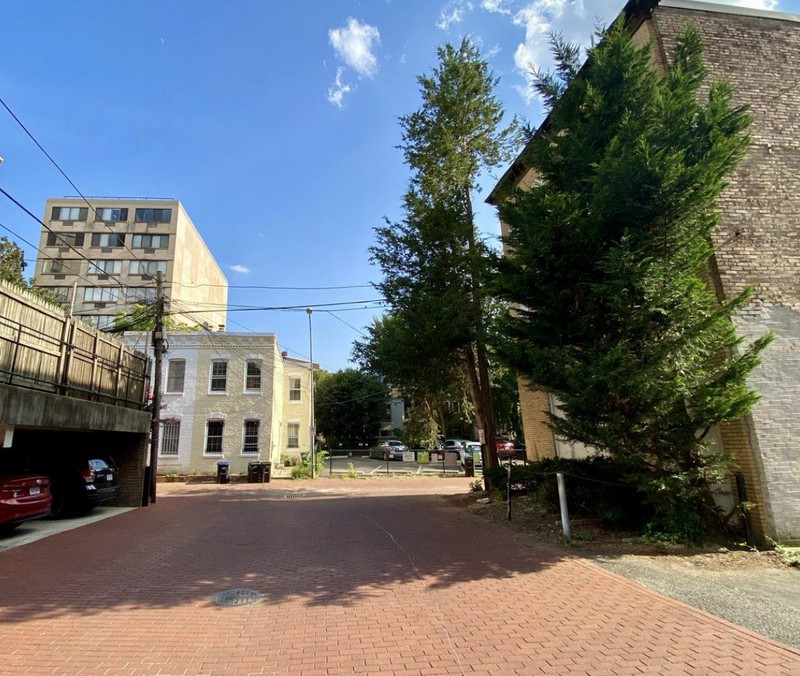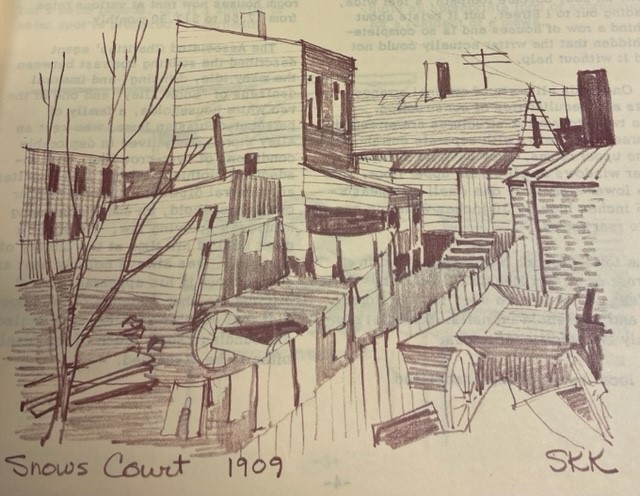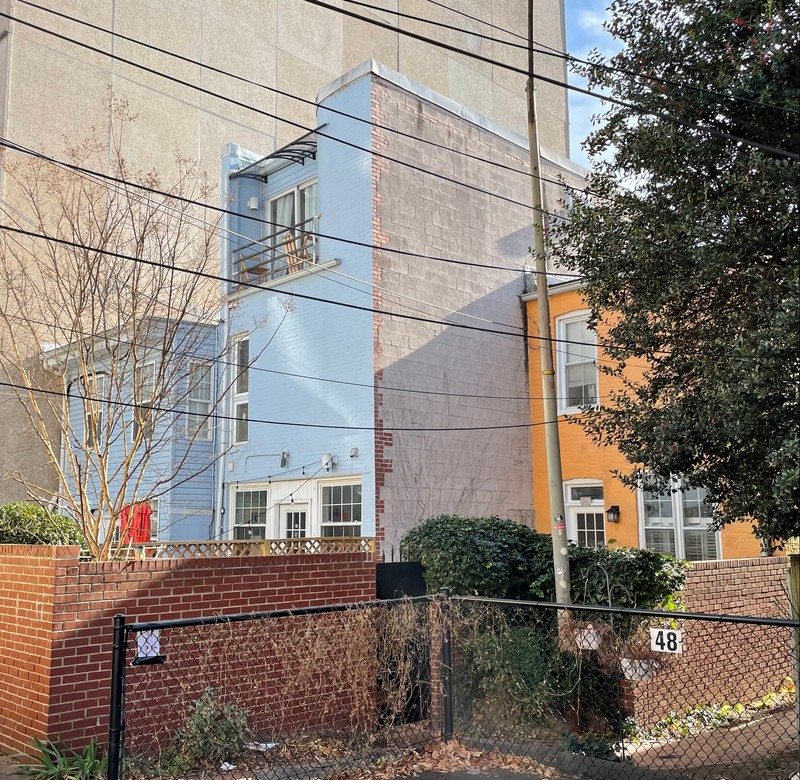Snows Court - DC's First Alley Houses
Introduction
Text-to-speech Audio
Snows Court hosts one of the earliest developments of alley house dwellings in D.C., with its first houses built by 1858. It is also boasts nearly 30 original brick houses - one of the largest collections in D.C. These simple two-story dwellings lacked indoor plumbing and housed D.C.'s poorer residents. From Teddy to Eleanor Roosevelt, "housing reformers" worked to eliminate these dwellings and vacate the residents. In the 1950s, new residents' renovation efforts succeeded in saving the remaining dwellings.
Images
Entering Snows Court from the I Street passageway in winter
.jpg)
THEN: Snows Court, 1938 - facing towards I St. passageway (with Washington Gas tanks in the background)

NOW: Snows Court, 2021 - facing towards I St. passageway (the clearer view today)

Foggy Bottom resident and artist Shirley Kennard's rendering of Snows Court in 1909, including wood-frame houses

The rear facades of the 2400 I St. houses from Snows Court, showing a variety of the houses' depths and heights

Backstory and Context
Text-to-speech Audio
The narrow passageway from I Street leads to Snows Court. This opening was originally a footpath that twisted about and behind row houses. At times, it was completely hidden, making it difficult for people to find their way out. The only official entrance to Snows Court is off of 25th Street (A “court” is an alley with only one entrance.)
Snows Court may have been the first alley to provide housing in Washington. It is a large alley, with a large number of original houses. The Foggy Bottom Historic District currently contains 29 of D.C.’s 108 remaining alley dwellings (second only the Georgetown, which has 40).
Washington was not the only city with alley housing, but such dwellings constituted a large portion of D.C.'s low cost housing. As part of Major L’Enfant’s original design of the City of Washington in 1791, city plats had been laid out as long narrow properties, with houses facing the streets. The rear of the properties had room for kitchens, stables and outer houses, with the alleys providing access.
Snows Court was named for C.A. Snow, publisher of the "National Intelligencer", an important (Whig) newspaper of the mid-1800s. In about 1858, he built a greenhouse and four wood frame dwellings here to house his Irish gardener and others. During the Civil War, Snow’s houses were used as army barracks.
During and after the Civil War, the city’s growing population, including many newly emancipated African Americans, needed housing. To house more people, D.C.'s long narrow lots were subdivided and alley-facing houses were built. The original alley houses were flimsy wooden sheds and shanties. By the 1880s, more substantial wood frame and brick houses were built. The houses in Snows Court were typically two floors high and two bays wide. Most of these houses had outside water pumps and privies and wood stove heat. By the 1890s, the Court’s population was at least 250 residents, nearly all of whom were African American. Foggy Bottom alleys housed approximately 1,500 people in total at that time.
Housing reformers argued that the alleys were overcrowded, unsanitary, bred diseases like tuberculosis, fostered criminal and immoral behavior, and posed a threat to the community. They argued alley houses should be demolished. In response to increasing public concerns, D.C. in 1892 prohibited new substandard alley dwellings. Several waves of efforts to eliminate alley housing followed, supported by President Theodore Roosevelt, President Woodrow Wilson’s first wife, and First Lady Eleanor Roosevelt, among others. (According to "The Evening Star" newspaper, on Christmas Eve 1938, First Lady Eleanor Roosevelt brought gifts and good wishes to “the poverty and gloom of Snows Court, a community of alley dwellers … a tucked-away, often forgotten slum.”)
Daily life was difficult for alley residents and their rents were much higher than their dwellings could justify. But the alleys were also functioning communities, with long-term residents, homes, stores, churches, bars, and routes for horse-drawn wagons delivering ice. Many residents worked as laborers and domestic servants or took in laundry. The assertions of criminal activity in the alleys were generally exaggerated. A 1938 Study of Snows Court characterized the residents as “one big happy but quarrelsome family.” (Swinney, p. 90)
From 1900 to the 1950s, throughout the city, alley houses were demolished or replaced by livery stables, then garages, parking lots, and apartment buildings.
Sources
Williams, Kim Prothro, The DC Historic Alley Buildings Survey, 2014 (see link below)
Borchert, James, Alley Life in Washington: Family, Community, Religion, and Folklife in the City, 1850-1970, Urbana: University of Illinois, 1980
Swinney, Daniel, D., "Alley Dwellings and Housing Reform in the District of Columbia," Masters Dissertation, University of Chicago, 1938 (available from ProQuest)
"Mrs. Roosevelt Has Busy Day going to Christmas Parties," The Evening Star (Sunday Star), Dec. 25, 1938, p. 16
Leone/Vogt, 2022
National Archives
Leone/Vogt, 2021
Foggy Bottom News, Feb. 1961
Vogt/Leone, 2021
